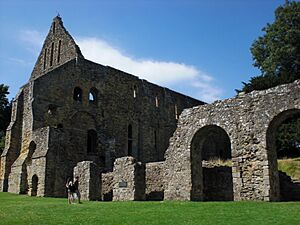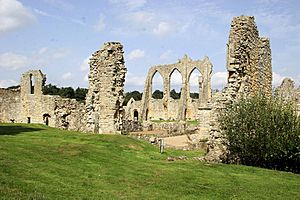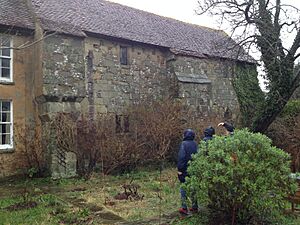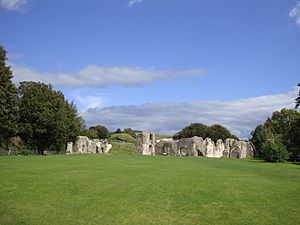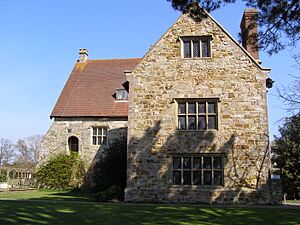List of monastic houses in East Sussex facts for kids
Monastic houses were special places where groups of people, like monks, nuns, or friars, lived together following religious rules. They dedicated their lives to prayer, study, and work. In the past, these houses were very important centers for learning, farming, and helping the community.
This article explores some of the monastic houses that once existed in East Sussex, England. Many of these places were dissolved, or closed down, in the 1500s during a time called the Dissolution of the Monasteries when King Henry VIII changed the religion of England. Today, you can still find ruins or parts of these old buildings, which tell us stories about life long ago.
Alien houses are included, as are smaller establishments such as cells and notable monastic granges (particularly those with resident monks), and also camerae of the military orders of monks (Knights Templars and Knights Hospitaller). Monastic hospitals are included where they had the status or function of an abbey, priory, friary or preceptor/commandery.
- Abbreviations and key
| Symbol | Status |
|---|---|
| None | Ruins |
| * | Current monastic function |
| + | Current non-monastic ecclesiastic function (including remains incorporated into later structure) |
| ^ | Current non-ecclesiastic function (including remains incorporated into later structure) or redundant intact structure |
| $ | Remains limited to earthworks etc. |
| # | No identifiable trace of the monastic foundation remains |
| ~ | Exact site of monastic foundation unknown |
| ≈ | Identification ambiguous or confused |
Locations with names in italics indicate possible duplication (misidentification with another location) or non-existent foundations (either erroneous reference or proposed foundation never implemented) or ecclesiastical establishments with a monastic name but lacking actual monastic connection.
| EH | English Heritage |
| LT | Landmark Trust |
| NT | National Trust |
Contents
- Monastic Houses in East Sussex
- Battle Abbey
- Bayham Abbey
- Beddingham Monastery
- Hailsham Cell
- Hastings Priory
- Hooe Grange
- Langney Priory
- Lewes Greyfriars
- Lewes Priory
- Michelham Priory
- Otham Abbey
- Ramstede Priory
- Robertsbridge Abbey
- Rotherfield Priory (Doubtful)
- Rye Monastic Houses
- Salehurst Abbey
- South Malling Monastery
- Warbleton Priory
- Wilmington Priory
- Winchelsea Monastic Houses
- Withyham Priory
- Images for kids
- See also
Monastic Houses in East Sussex
Here is a list of some of the important monastic houses in East Sussex:
Battle Abbey
Battle Abbey was a monastery for Benedictine monks. It was founded in 1067 by William the Conqueror to remember the Battle of Hastings. The abbey was dissolved in 1538. Today, it is managed by English Heritage and you can visit its impressive ruins.
Bayham Abbey
Bayham Abbey was home to Premonstratensian Canons, a type of religious community. It was founded around 1207. This abbey was created by joining two other smaller monasteries. It was dissolved in 1525. The ruins are now looked after by English Heritage.
Beddingham Monastery
This was a very old Saxon monastery, possibly from the time of King Offa (757–796). It might have been destroyed during Viking raids in the 9th century. Not much is known about its exact location or what happened to it.
Hailsham Cell
Hailsham Cell was a small religious house, or "cell," that belonged to Bayham Abbey. It was founded after 1260 for Premonstratensian Canons. The canons living there were expelled a few times but later restored.
Hastings Priory
Hastings Priory was a priory for Augustinian Canons Regular. It was founded between 1189 and 1199. Because the sea was eroding the land, the priory had to be moved further inland to Warbleton. It was dissolved in 1413 and again in 1539.
Hooe Grange
This was a "grange," which means a farm or estate, run by Benedictine monks. It was dependent on a larger monastery in France called Bec-Hellouin. It was founded in 1106 but closed before 1230.
Langney Priory
Langney Priory was a "grange" for Cluniac monks, connected to Lewes Priory. It was established before 1121. Today, the old priory building has been turned into a house.
Lewes Greyfriars
This was a house for Franciscan Friars Minor, also known as Greyfriars because of their grey robes. It was founded before 1241 and dissolved in 1538.
Lewes Priory
Lewes Priory was a very important monastery for Cluniac monks. It was founded in 1077 by Earl William de Warenne and his wife Gundreda. For a long time, it was dependent on a monastery in Cluny, France, but it became independent in 1351. The priory was dissolved in 1537.
Michelham Priory
Michelham Priory was home to Augustinian Canons Regular. It was founded in 1229. After it was dissolved in 1536, parts of the priory were used to build a large house. Today, it is owned by the Sussex Archaeological Society and is open to visitors.
Otham Abbey
Otham Abbey was a monastery for Premonstratensian Canons. It was founded around 1180. Later, it joined with Bayham Abbey between 1208 and 1211. The abbey was dissolved in 1526. Today, the site includes Otteham Court and St Lawrence's Chapel.
Ramstede Priory
This priory was for Benedictine nuns. It was founded between 1174 and 1184 by Richard, who was the Archbishop of Canterbury. However, it was dissolved before 1204, and the nuns were moved away.
Robertsbridge Abbey
Robertsbridge Abbey was a monastery for Cistercian monks. The community first started at Salehurst in 1176 and then moved to Robertsbridge around 1250. The abbey was dissolved in 1538. The site is now a private house.
Rotherfield Priory (Doubtful)
This is a Benedictine monks priory that might have been founded around 790. However, its existence is uncertain, and the documents about it are not very clear. It was an "alien house," meaning it was dependent on a monastery in France.
Rye Monastic Houses
Rye had several monastic houses:
- Rye Austin Friars, earlier site: This was for Augustinian Friars, founded in 1364. It was destroyed by French attackers in 1377.
- Rye Austin Friars: After the first site was destroyed, the friars moved to a new location in Rye between 1378 and 1379. This friary was dissolved in 1538. Part of its chapel still exists today.
- Rye Friars of the Sack: This group of friars was founded around 1263. Their order was abolished before 1307, and the building was then used for other purposes.
- Rye – Friary of St Anthony: This was for Conventual Franciscan Friars. A church was opened here in 1900, and the Franciscans took care of the parish from 1910.
Salehurst Abbey
Salehurst Abbey was the first home for the Cistercian monks who later moved to Robertsbridge Abbey. It was founded in 1176. The monks moved to Robertsbridge around 1250.
South Malling Monastery
This monastery might have been for Benedictine monks and was founded before 686. Later, it became a "collegiate" church, meaning it had a group of clergy living together but not necessarily under strict monastic rules. It was dissolved in 1547.
Warbleton Priory
Warbleton Priory was for Augustinian Canons Regular. The community originally started at Hastings Priory. It was refounded at Warbleton in 1413 after being moved from Hastings. It was dissolved in 1536. Today, parts of the priory are included in a private farm.
Wilmington Priory
Wilmington Priory was a cell and later a priory for Benedictine monks. It was dependent on a monastery in France. It was founded before 1086. The priory was dissolved in 1414. Today, the site is occupied by a local church.
Winchelsea Monastic Houses
Winchelsea also had several monastic houses:
- Winchelsea Black Friars, earlier site: This was for Dominican Friars, founded in 1318 on the south cliff. They had to move due to the sea threatening the site.
- Winchelsea Blackfriars: The Dominican Friars moved to this new site in 1358. This priory was dissolved in 1538.
- Winchelsea Greyfriars, New Town: This was for Franciscan Friars. They moved here between 1283 and 1287 from an older site in Winchelsea. It was dissolved in 1538.
- Winchelsea Greyfriars, Old Town: This was the first home for the Franciscan Friars in Winchelsea, founded before 1242. They later moved to the "New Town" site.
Withyham Priory
Withyham Priory was a "grange" for Benedictine monks, connected to monasteries in France. It was founded in 1249 and dissolved in 1413. Later, it was granted to King's College, Cambridge.
Images for kids
See also


